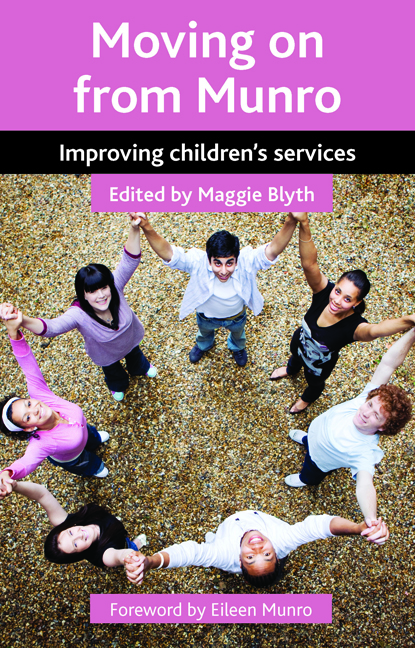Book contents
- Frontmatter
- Contents
- List of abbreviations
- Notes on contributors
- Acknowledgements
- Foreword
- Introduction
- 1 Getting the right things right
- 2 Child protection: 40 years of learning but where next?
- 3 Doing something different: reconfiguring front-line services: opening up the market
- 4 Re-imagining early help: looking forward, looking back
- 5 Children should be seen and heard: understanding the child’s experience
- 6 Responding to adolescent risk: continuing challenges
- 7 Moving on with Munro: child sexual exploitation within a child protection framework
- 8 Missing children post-Munro
- 9 Symbolic half-measures? On local safeguarding children boards, their contributions and challenges
- Conclusion
- Index
7 - Moving on with Munro: child sexual exploitation within a child protection framework
Published online by Cambridge University Press: 03 February 2022
- Frontmatter
- Contents
- List of abbreviations
- Notes on contributors
- Acknowledgements
- Foreword
- Introduction
- 1 Getting the right things right
- 2 Child protection: 40 years of learning but where next?
- 3 Doing something different: reconfiguring front-line services: opening up the market
- 4 Re-imagining early help: looking forward, looking back
- 5 Children should be seen and heard: understanding the child’s experience
- 6 Responding to adolescent risk: continuing challenges
- 7 Moving on with Munro: child sexual exploitation within a child protection framework
- 8 Missing children post-Munro
- 9 Symbolic half-measures? On local safeguarding children boards, their contributions and challenges
- Conclusion
- Index
Summary
Introduction
This chapter argues for a conceptual shift in our understanding of child protection. Drawing on some of the key lessons from Munro's (2011) review of child protection, it argues that our understanding of child protection must develop from one focused on protecting younger children from abuse in the home to one incorporating the protection of older children from abuse located and experienced outside the home.
The chapter uses child sexual exploitation (CSE) as an example to illustrate the complexities of extending the child protection framework to embrace the needs of older children, particularly adolescents. It develops Munro's call for a systemic approach to understanding the difficulties faced by those working in child protection and her request for relationship-based thinking to inform the supervision of practitioners, helping them manage the anxieties that emerge when responding to difficult and emotive casework. It argues that future policy and practice to protect children from sexual exploitation should not only be modelled on reviews of recent cases where abusers have been prosecuted. Rather than using these reviews to blame individual practitioners for failing to recognise the exploitation of a child, it calls for a more nuanced understanding of the social context in which the practitioner is functioning. This is particularly relevant for practitioners understanding the social context in which a child's capacity to consent to sexual activity may be abused.
I argue that relationship-based child protection interventions with older children could be enhanced through learning action partnerships (LAPs). Originally developed by staff working with the Oak Foundation developing sustainable interventions to prevent child abuse, LAPs offer a model of engaging with young people as partners, recognising their capacity either to engage or disengage from the support and protection offered by children's services. LAPs provide us with a model for developing safeguarding with adolescents, who, unlike babies or toddlers, have the capacity to exert their own agency through taking safeguarding into their own hands, by ‘going missing’ or by rejecting support through other means.
In summary, the chapter moves through three stages. First, it notes that most discourses about ‘child protection’, including those addressed by the Munro review, have, in the main, overlooked the needs of vulnerable older teenagers who are being abused as they approach adulthood.
- Type
- Chapter
- Information
- Moving on from MunroImproving Children's Services, pp. 125 - 142Publisher: Bristol University PressPrint publication year: 2014



